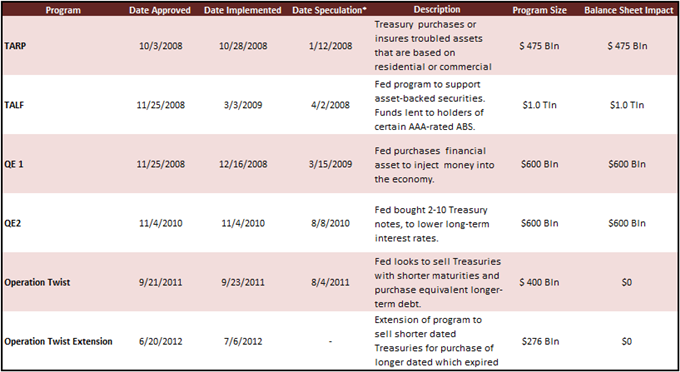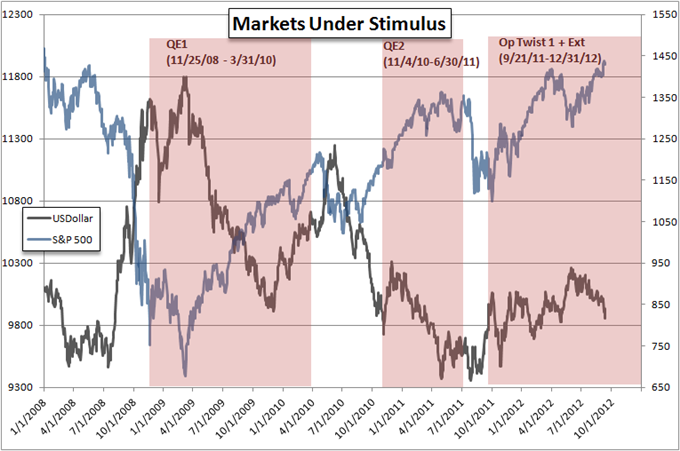The outcome of the FOMC meeting is not just a new round of quantitative easing, some might call it QE3. What the Fed announced represents a new chapter in its policy response. The first distinguishing aspect of its decision is the open-ended nature of it. While it has not indicated formal labor market targets, and indeed Bernanke shied away from such at his press conference, the FOMC committed itself to expanding its balance sheet until there is substantial and sustained improvement in the labor market.
This means that there won’t be a QE4 or a QEn as some pundits have forecast. Instead, the FOMC now is willing to extend its asset purchases indefinitely, conditioned on the improvement in the labor market. This means that unless the labor market shows significant improvement in the coming months, the Fed is likely to increase its asset purchases when Operation Twist is completed at the end of the year.
The second distinguishing characteristic of the Fed’s decision is that there is a new element of an American version of the UK’s funding-for-lending scheme. The Fed will focus its new long term asset purchases not just on mortgage-backed securities in general, but will concentrate its efforts on newly issued to to-be-announced MBS. It is expected (hoped?) that this will generate more mortgage issuance. As banks sell their MBS holdings to the Fed, it can replace them with new MBS. This is consistent with Bernanke’s repeated calls on Congress and the government to deliver mortgage relief.
Initially, the fact the Fed committed itself to buying $40 bln of MBS a month may have seemed disappointing given that the QE2 had the Fed buying $600 bln over 7-8 months. However, this is mitigated by the likelihood that when Operation Twist is complete, the Fed increases the amount of MBS it buys. In addition, this level of purchases, coupled with the ongoing recycling of Treasury proceeds means that the FOMC is committed to buying more than half of the anticipated new MBS issuance.
See the differences between the Fed programs since 2008:

Prior Fed Programs - Click to enlarge
And the resulting effects on markets:

Fed Programs and Markets - Click to enlarge
There may have been some disappointment too that the Fed extended its rate guidance from late-2014 to mid-2015. However, this may have more to do with the Fed’s forecasting horizon and it was only with the new forecasts that the Fed staff event ventures a look at 2015. It seemed clear from Bernanke’s press conference that should the economy continue to disappoint, extending the guidance further out remains an option.
Given the ECB’s committed to “do whatever is necessary” and its willingness to buy an unlimited amount of government bonds up to 3-years in duration, one may see some similarities with the Fed’s decision. However, there are a few key differences to keep in mind. First, the “unlimited” nature of the ECB’s pledge is more marketing than substantive. There is a fixed amount of debt with 3-years or less duration that Spain has, for example, and reports indicate that the ECB will use moral suasion to prevent a country from gaming the rules by issuing proportionately more in then tenor.
Second, the ECB has not bought a single bond and it may not unless a country (Spain?) requests, but given the decline in yields and various other considerations, Prime Minister Rajoy continues to seem to be in no hurry to seek such support and Italy seems to remain even further away from asking. In contrast, the Fed’s policy will be implemented nearly immediately.
Third, the ECB, perhaps because of its largest and most important member, is more sensitive to the distinction between monetary and fiscal policy then the Federal Reserve seems to be. Arguably, a more aggressive fiscal policy and congressional action to provide mortgage relief would have reduced the Fed’s need to do so. In this regard, the US seems more pragmatic than Europe.
Lastly, the Fed’s actions, and to a lesser extent the ECB’s OMT increase pressure on the BOJ extend its own QE at next week’s (Sept 18-19) meeting. Deflationary forces have not been arrested and the weakness in foreign demand has knock-on effects on Japanese industrial output. The strong yen exacerbates these negative influences. Yet, Japan would likely find little support for material intervention in the foreign exchange market from its G7 peers.
See More related posts from Marc:
Are you the author?
He has been covering the global capital markets in one fashion or another for more than 30 years, working at economic consulting firms and global investment banks. After 14 years as the global head of currency strategy for Brown Brothers Harriman, Chandler joined Bannockburn Global Forex, as a managing partner and chief markets strategist as of October 1, 2018.
Previous post
See more for 4.) Marc to Market
Next post
Tags:
Bank of Japan,
Ben Bernanke,
ECB,
Federal Reserve,
Marc Chandler,
QE2,
QE3,
Quantitative Easing









































